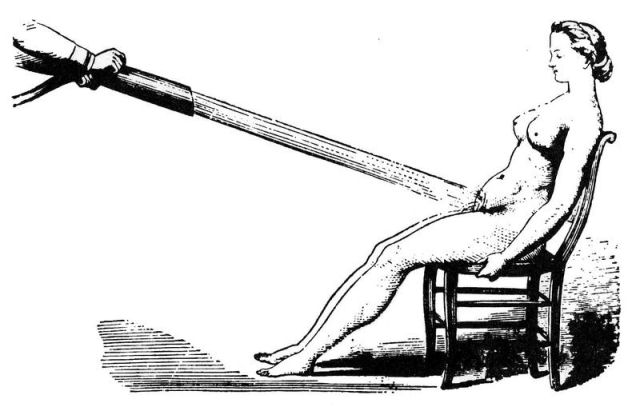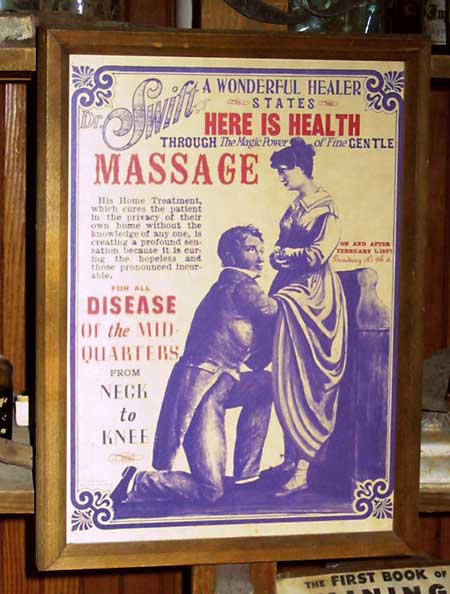Balls and Walnuts
more than you ever wanted to know
- About
- All Change
- Big pix
- Dormies
- Ear, Nose, Throat, and Soul
- Heaven on Earth
- Karen’s memoriam . . . booklet and eulogy
- Lyvvie’s email
- Magic Schoolbus does your nose and throat
- Nest: scene one
- Sex and the Single Wendigo
- Sprouts
- The Mechanic
- Two Birds, One Stone
- Excerpt: Gator and Shark Save the World
Hysterical

French treatment of hysteria, circa 1860.
So much of my work as an ENT is unglamorous — picking noses, digging decades-old wax from people’s ears, draining abscesses. It gets me down sometimes, especially when (as happened last week) a rug monkey coughs in my face and I know I’ll be sick within 48 hours.
Times like this, I need historical perspective.
Plato and Hippocrates described a condition known as hysteria (derived from the Greek word for uterus). From Hippocrates’ Diseases of Women,
If a woman suddenly becomes voiceless you will find her legs cold, as well as the knees and the hands. And if you then palpate the uterus, it is not in its proper place; her heart palpitates, she gnashes her teeth, there is copious seat, and all the other features characteristic of those who suffer from the “sacred disease” (epilepsy), and they do all sorts of unheard-of things.
About 1500 years earlier, an Egyptian papyrus noted “peculiar abnormalities produced by movement of the uterus, moving upwards from the pelvis, applying pressure on the diaphragm and giving rise to bizarre physical and mental symptoms.”
Hysteria truly came into vogue in the 19th Century. According to the Wikipedia article, “female hysteria” referred to
a wide array of symptoms including faintness, nervousness, insomnia, fluid retention, heaviness in abdomen, muscle spasm, shortness of breath, irritability, loss of appetite for food or sex, and a “tendency to cause trouble.”
I shouldn’t bitch about cleaning ear wax. 150 years ago, I might have been treating hysteria. Again from Wikipedia:
Patients diagnosed with female hysteria would undergo “pelvic massage” — manual stimulation of the woman’s genitals by the doctor to “hysterical paroxysm”, which is now recognized as orgasm.
. . . .
Rachael P. Maines, author of The Technology of Orgasm: “Hysteria,” the Vibrator, and Women’s Sexual Satisfaction, has observed that such cases were quite profitable for physicians, since the patients were at no risk of death but needed constant treatment. The only problem was that physicians did not enjoy the tedious task of massage: The technique was difficult for a physician to master and could take hours to achieve “hysterical paroxysm.” Referral to midwives, which had been common practice, meant a loss of business for the physician.

From Explore Historic California: Dr. Swift’s Cure for Hysteria
In the 1880’s [a] British physician, Joseph M. Granville, was searching for a better way to ‘cure’ hysteria in his female patients. By 1883, he had patented the first electromechanical vibrator, a medical device that could perform “therapeutic massage” in a quick and effective manner.
Early in the 20th century, portable home units were advertised in women’s magazines and almanacs, thus making the purchase of a personal vibrating massager through mail order a popular alternative to visiting the doctor for prescribed ‘treatments.’
A bit more history:
Hamilton Beach patented its first take-home vibrator in 1902, making the vibrator the fifth electrical appliance to be introduced into the home – after the sewing machine and long before the iron.
You can even buy one of these puppies on eBay, but I have to warn you: it looks more like a torture device than a “massager.”
Not all hysterical patients were treated thus. Single women were advised to marry, married women were advised to have sex more often — or get pregnant. But recalcitrant patients came to their physician for definitive treatment.
The diagnosis of hysteria lingered on into the 1950s, when the profession of psychiatry decided to discard the word altogether. That doesn’t stop the alternative medicine folks from trying to treat it as a real condition. On Home Remedies, I learned that lettuce juice, honey, and jambul fruit all can be used to treat hysteria. Homeopathy treatments abound (although, in fairness, they’re thinking about hysteria in the more modern sense — that of a conversion disorder), and hysteria has its own acupuncture point, too.
Yup, some ideas are slow to die. In the case of female hysteria, the stubbornness of this meme speaks volumes about our paternalistic society. Some men can’t understand female behavior, so what do they do? Call it a disease. Even in Western medicine, hysteria lives on as conversion disorder, which this New York Times article assures us really does exist*.
Hat tip to my amazing wife, who turned up this material yesterday while reading literary essays on Ethan Frome.
D.
*In case anyone asks, yes, I have seen a conversion disorder — hysterical deafness.
In a guy.
21 Comments
Find it
Blogroll
- Beth
- Blue Gal
- Charlene Teglia
- Chris and Dean
- Crystal
- dcr, the one, the only
- Erin O’Brien
- Fanatic Cook
- fiveandfour
- Gabriele
- If I Ran the Zoo
- Indecision 2008!
- jmc
- Kate Rothwell
- Kris Starr
- Lyvvie
- Matt’s recovery blog
- Mike Imlay
- Paperback Writer
- Pat Johanneson
- Raw Dawg Buffalo
- Science Blogs
- Shaina
- Shelbi
- Smart Bitches
- Steve Bunche
- Steven Pirie
- Tam’s blog
- The Amanda Files
Archives
Meta
Categories
Pages
- About
- All Change
- Big pix
- Dormies
- Ear, Nose, Throat, and Soul
- Excerpt: Gator and Shark Save the World
- Heaven on Earth
- Karen’s memoriam . . . booklet and eulogy
- Lyvvie’s email
- Magic Schoolbus does your nose and throat
- Nest: scene one
- Sex and the Single Wendigo
- Sprouts
- The Mechanic
- Two Birds, One Stone
Shit. I’ve been using it the wrong way.
Hmm, the treatment for hysteria sounds not unappealing. Perhaps I should succumb more often.
The technique was difficult for a physician to master and could take hours to achieve “hysterical paroxysm.â€
damn, wonder what took them so long. My pal who’s Catholic said a priest explained to her and her husband-to-be (during pre-marital counseling) that men are light switches and women are electic stoves when it comes to sexual excitement. Maybe our ancestresses were wood stoves and the doctors had to go out and gather kindling?
damn, I need an editor.
Or a ‘Preview’ button…
Kwitcher whinin you two. A simple request to fix something would work wonders — I can edit your messages, after all. Case in point, look what I just did to Kate’s second comment.
BTW, I’m curious how much of this is new info to y’all. I knew about “female hysteria,” of course (I was a psychiatrist wannabe at one point), but I didn’t know about the treatment options 😛
I love how the female midwives could easily alleviate the problem whereas the men, not thinking that the hysteria might have something to do with women’s lives sucking and, oh yeah, them never having orgasms, just went and invented a machine to do it.
On the other hand, those little machines have been quite a boon to the world… ;o)
I’m hardly in a position to kvetch – my blog doesn’t offer a preview button, either. Tho’ I do offer a similar set of editing services… 😉
I knew most of this – but then, my wife’s a psychologist. I wasn’t aware of the vibrator’s place of honor in the pantheon of small appliances – predating the iron, who would have guessed?
Yeah, DN, don’t go knockin vibrators 🙂
PS: See, first the light bulb went off, then Edison thought, “At last I’ll be able to satisfy Mrs. Edison!”
*groan*
That, or it was “Now maybe Ford & Firestone will finally leave me alone!”
“first the light bulb went off” vs. “When the light bulb went off”
Or, I could actually type what is really there… No, Ctrl+C -> Ctrl+V isn’t good enough for me, nope. I’ve got to get fancy and transcribe.
*sigh* And, like, link to the correct URL… Too many tabs open, too few synapses firing.
I have a convenient form of deafness, where I’m not able to hear lower tones. This means that most men are reduced to a mumble and I just don’t bother to listen to them anymore.
My husband hates it that he’ll be talking and I’ll not be listening but one of the kids says something quietly in another room and I’ll hear them.
I’m reminded of the movie “Road to Wellville.”
By the way, loved this post.
Preview does nothing for me. It takes about five minutes for the fog to clear so I can rearrange words to go in the right order.
pathetic brain alert: I stared at that second comment for the longest time, trying to recall writing it. Apparently I believe I can announce the desire to have someone’s babies — and not remember saying it.
mebbe I’m hysterical? hmmm… Time to go for a treatment.
Now I’m really wondering where I first found out about this.
I have to say, I’d probably be hysterical, too, if I were orgasm deficient.
Oh. Ohhhhh. Heh. I remember, now. My mother-in-law told me. She also told me she’d read that women ought to have several orgasms a day–for optimal health. Wise woman.
What second comment, Kate?
(Bwaaahahhaaaa! the power of the edit comment function strikes again!)
Several a day, Darla? Sounds good to me.
I’m with Darla! Kegels be damned, bring on the orgasms.
Think of how liberating those first vibrators must have been. Thereafter, the woman would no longer need to pay some strange doctor to give them a massage . . .